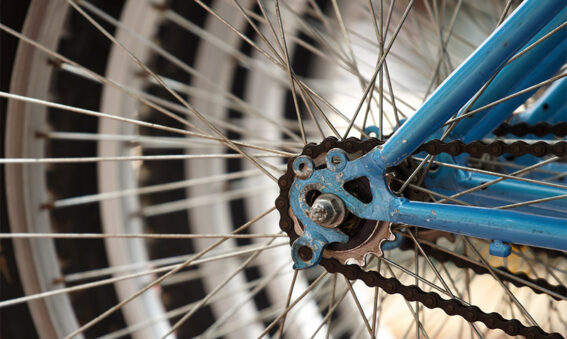Whatever your ride, road, tri, gravel, mtb, it will need some new parts at some point if you are putting int he miles. So, when will it need these new parts you ask? No worries, below is a guide to help you judge how long the commonly wearing parts should last and when you should replace them.
Tires
As the number one concern for most cyclists, your bike’s sneakers are a very important item to keep an eye on. Your tires are your connection to the road and take quite a beating when you really examine what they go through. They are in constant contact with the hot and rough pavement, rocky trail surface, trainer roller, or whatever destructive surface you may be riding on. Over time they are designed to wear down by slowly loosing rubber against the riding surface while giving you that ever-important traction you need to ride. In order to get the most out of your tires and keep you safe while riding you should check them regularly for nicks, cuts, and damage as well as keep them inflated correctly.
Generally speaking, you should be able to get about 2000 miles or so out of a set of road tires. I say “about” 2000 miles, because the type of tire you are riding has a lot to do with the mileage you can expect to see from them. For example, a tire geared more towards road racing will typically have a soft and sticky rubber compound and a softer casing (the base cotton structure of a bicycle tire) and will usually wear down in less than 2k miles. Whereas, a tire with a harder rubber compound and a thicker casing will typically last 3k or more depending on the riding conditions. You will want to inspect your tires once a month or so to check for any damage like, cuts, scrapes, or worn areas. Many brands of tires have wear indicators that can help you determine when it is time to replace. Often times a damaged tire will need to be replaced long before it has worn out! To increase the life expectancy of your sneakers you can rotate them about every 500 miles or so to help balance the wear patterns that will develop.
Chain
For sure the second most common replacement item on your steed, your chain serves to provide you with a solid connection between your cranks and the wheel. Your chain provides a way to transfer all the power you make in your legs, to your rear wheel as efficiently as it can. It provides an invaluable service, and only asks for a bit of lube occasionally and a nice bath once in a while.
On average, you should be able to get about 3000 miles or so from most road bicycle chains, and about 1500 miles on a mountain bike chain. That number is largely subjective to the type of riding conditions and care that it receives during its life cycle. For example, a mountain bike chain lives in relatively severe conditions and is subjected to dusty, dirty, and muddy trails so it usually will not last as long as a road chain. And, a commuter who rides in all types of weather conditions including rain and snow may experience more rust related wear and may not see quite as many miles. However, if you are diligent about keeping the chain lubricated properly about every third ride or so and de-greasing regularly, you should expect to see typical mileage. Your cassette and chain rings will also last longer due to a cleaner and well lubricated chain. You can typically get about 3 chains per cassette and about 6 chains per set of chain rings.
Cables and Housings
Often overlooked as a common wear item, your cables and cable housings should be checked regularly as they can be a safety issue if they are damaged or worn. They serve to reliably connect your shifters and brake levers to the derailleurs and brakes, but may not perform correctly if worn. When worn beyond their intended life cycle, cables and housings can fail by braking, fraying, sticking, or even exploding!
Generally speaking, cables and housings typically last about two riding seasons. However, there are a few factors that can prematurely age your system. Your cables are comprised of a group of finer cables and can act somewhat like a wick, soaking up water and sweat and drawing it up the cable into the housing, which in turn corrodes and rusts the cable. This corrosion will add excess friction to the system, which in turn affects the shifting and braking performance. The cable housings can also be affected by rust and corrosion or may become brittle and weak from the sun’s UV rays and dry-rot. Cable housings may become cracked and dried out, swollen from rust, or scraped from rubbing on the frame which could cause a catastrophic failure at a very in opportune moment! As a general rule, I typically recommend replacing them every two riding seasons for the average cyclist. If you are a heavy sweater or ride in particularly harsh conditions, we may want to replace them annually. A fresh set of cables and housings is a great way to return that new feeling to your bike and will often improve the performance of the shifting and braking.

